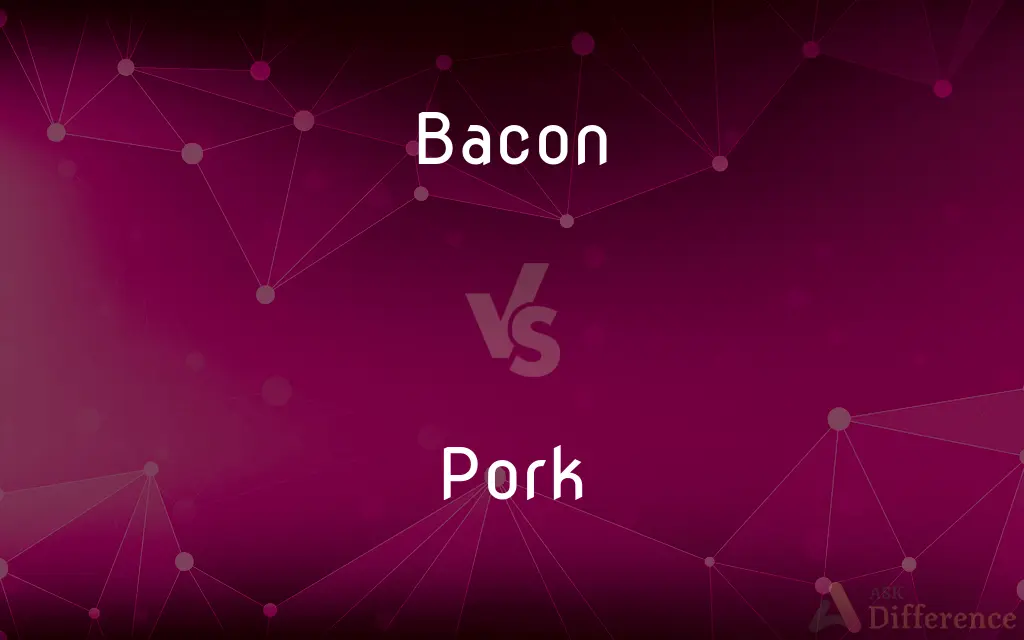Bacon vs. Pork — What's the Difference?
Edited by Tayyaba Rehman — By Maham Liaqat — Updated on March 7, 2024
Bacon is cured and smoked pork belly or back cuts, known for its rich flavor and crisp texture, while pork refers broadly to the meat of the pig, served in various forms and cuts.

Difference Between Bacon and Pork
Table of Contents
ADVERTISEMENT
Key Differences
Bacon is a specific type of pork product derived from the belly or back of a pig, which undergoes a curing process with salt, and often smoked, giving it a distinctive flavor and texture. On the other hand, pork encompasses all parts of the pig used for food, including various cuts like loin, chop, and shoulder, which can be cooked in numerous ways without the need for curing.
While bacon is celebrated for its crispy texture and a salty, smoky taste that makes it a popular choice for breakfast and garnishing in various dishes, pork in its broader variety offers a wide range of flavors and textures depending on the cut and cooking method, such as roasting, grilling, or stewing.
The preparation of bacon involves curing it in a salt mixture, which may also include sugar and spices, and then smoking it over wood chips to enhance its flavor. Pork cuts, however, may be simply seasoned and cooked, presenting a more natural taste of the meat itself, varying from mild to rich based on the specific cut and its fat content.
Nutritionally, bacon is higher in fat and calories due to the curing process and the particular cuts used, making it a richer but also more calorie-dense option. Whereas, pork offers a variety of nutritional profiles across its different cuts, with leaner options like tenderloin providing a healthier choice high in protein and lower in fat.
In culinary uses, bacon often serves as a flavorful addition to dishes, enhancing other ingredients with its distinctive taste, while pork, given its versatility, can be the centerpiece of a meal, such as a pork roast or pork chops, showcasing the meat's natural flavors and textures.
ADVERTISEMENT
Comparison Chart
Definition
Cured and smoked pork belly or back, known for its crispy texture and smoky flavor.
The meat from a pig, available in various cuts like loin, chop, and shoulder.
Preparation
Cured with salt (and sometimes sugar and spices) and smoked.
Cooked using various methods like roasting, grilling, or stewing without curing.
Flavor
Salty and smoky, with a rich, intense taste.
Ranges from mild to rich, depending on the cut and preparation.
Nutritional Content
Higher in fat and calories, often considered less healthy.
Offers lean options like tenderloin, generally more varied in nutritional profile.
Culinary Use
Used as a flavor enhancer in dishes or served as a breakfast item.
Serves as the main ingredient in diverse dishes, highlighting the meat's natural flavors.
Compare with Definitions
Bacon
Known for its rich texture, bacon is a delicacy.
For breakfast, he preferred bacon over sausage.
Pork
Pork can be cooked in various ways, such as stewing.
He slow-cooked the pork until it was tender.
Bacon
Bacon undergoes smoking, enhancing its taste.
The bacon's smoky aroma filled the kitchen.
Pork
Pork refers to any meat from a pig, versatile in cooking.
They served roasted pork at the dinner.
Bacon
A breakfast staple, bacon is often fried until crispy.
She loves her bacon crispy and golden.
Pork
Popular cuts include pork chops and tenderloin.
She prepared grilled pork chops for lunch.
Bacon
Bacon is cured pork belly, prized for its smoky flavor.
He cooked the eggs with a side of crispy bacon.
Pork
The flavor of pork varies with the cut and preparation.
The smoked pork had a deep, rich flavor.
Bacon
Used to add depth to dishes, bacon is versatile.
They topped the soup with crumbled bacon for extra flavor.
Pork
Lean cuts like tenderloin offer healthier options.
For a lean meal, she chose pork tenderloin.
Bacon
Bacon is a type of salt-cured pork made from various cuts, typically from the pork belly or from the less fatty back cuts. It is eaten on its own, as a side dish (particularly in breakfasts), or used as a minor ingredient to flavour dishes (e.g., the club sandwich).
Pork
Pork is the culinary name for the meat of a domestic pig (Sus scrofa domesticus). It is the most commonly consumed meat worldwide, with evidence of pig husbandry dating back to 5000 BC.Pork is eaten both freshly cooked and preserved.
Bacon
The salted and smoked meat from the back and sides of a pig.
Pork
The flesh of a pig or hog used as food.
Bacon
Cured meat from the sides, belly, or back of a pig.
Pork
Government funds, appointments, or benefits dispensed or legislated by politicians to gain favor with their constituents
"However much [the voters] may distrust Congress and dislike pork, the advantages of being represented by an incumbent with seniority are hard to deny" (Richard Lacayo).
Bacon
Thin slices of the above in long strips.
Pork
To eat ravenously; gorge oneself. Used with out.
Bacon
The police or spies.
Run! It's the bacon!
Pork
To become fat. Used with out.
Bacon
Road rash.
Pork
To engage in sexual intercourse with (another). Used especially of a man.
Bacon
A saucisse.
Pork
(uncountable) The meat of a pig; swineflesh.
The cafeteria serves pork on Tuesdays.
Bacon
The back and sides of a pig salted and smoked; formerly, the flesh of a pig salted or fresh.
Pork
Funding proposed or requested by a member of Congress for special interests or their constituency as opposed to the good of the country as a whole.
Bacon
Roger Bacon. A celebrated English philosopher of the thirteenth century. Born at or near Ilchester, Somersetshire, about 1214: died probably at Oxford in 1294. He is credited with a recognition of the importance of experiment in answering questions about the natural world, recognized the potential importance of gunpowder and explosives generally, and wrote comments about several of the physical sciences that anticipated facts proven by experiment only much later.
The Franciscan monk, Roger Bacon (c. 1214 - 1294) was an important transitional figure in chemistry as he was trained in the alchemical tradition, but introduced many of the modern concepts of experimental science. Bacon believed that experiment was necessary to support theory, but for him the theory as presented in the Bible was true and the experiment only underlined that truth. One of Bacon's lasting contributions was his references to gunpowder, bringing this discovery to the general attention of literate Europeans. Gunpowder had been known for centuries in China, being used for fireworks and incendiary grenades. Gunpowder is a simple mixture of charcoal, sulfur, and potassium nitrate (known generally as saltpeter). Saltpeter is a major component of guano (bird droppings) and may be recovered from privies where it will crystallize. By 1324, Europeans had discovered the art of using gunpowder to fire a projectile, marking the end of the period of castles and knights in armor.
Roger Bacon was Born at or near Ilchester, Somersetshire, about 1214: died probably at Oxford in 1294. He was educated at Oxford and Paris (whence he appears to have returned to England about 1250), and joined the Franciscan order. In 1257 he was sent by his superiors to Paris where he was kept in close confinement for several years. About 1265 he was invited by Pope Clement IV. to write a general treatise on the sciences, in answer to which he composed his chief work, the "Opus Majus." He was in England in 1268. In 1278 his writings were condemned as heretical by a council of his order, in consequence of which he was again placed in confinement. He was at liberty in 1292. Besides the "Opus Majus," his most notable works are "Opus Minus," "Opus Tertium," and "Compendium Philosophiae." See Siebert, "Roger Bacon," 1861; Held, "Roger Bacon's Praktische Philosophie," 1881; and L. Schneider, "Roger Bacon," 1873.
Dr. Whewell says that Roger Bacon's Opus Majus is "the encyclopedia and Novam Organon of the Thirteenth Century, a work equally wonderful with regard to its general scheme and to the special treatises with which the outlines of the plans are filled up.
Pork
Law enforcement, those who side with criminal prosecution
Bacon
Francis Bacon. A celebrated English philosopher, jurist, and statesman, son of Sir Nicholas Bacon. Born at York House, London, Jan. 22, 1561: died at Highgate, April 9, 1626, created Baron Verulam July 12, 1618, and Viscount St. Albans Jan. 27, 1621: commonly, but incorrectly, called Lord Bacon. He studied at Trinity College, Cambridge, April, 1573, to March, 1575, and at Gray's Inn 1575; became attached to the embassy of Sir Amias Paulet in France in 1576; was admitted to the bar in 1582; entered Parliament in 1584; was knighted in 1603; became solicitor-general in 1607, and attorney-general in 1613; was made a privy councilor in 1616, lord keeper in 1617, and lord chancellor in 1618; and was tried in 1621 for bribery, condemned, fined, and removed from office. A notable incident of his career was his connection with the Earl of Essex, which began in July, 1591, remained an intimate friendship until the fall of Essex (1600-01), and ended in Bacon's active efforts to secure the conviction of the earl for treason. (See Essex.) His great fame rests upon his services as a reformer of the methods of scientific investigation; and though his relation to the progress of knowledge has been exaggerated and misunderstood, his reputation as one of the chief founders of modern inductive science is well grounded. His chief works are the "Advancement of Learning," published in English as "The Two Books of Francis Bacon of the Proficience and Advancement of Learning Divine and Human," in 1605; the "Novum organum sive indicia vera de interpretatione naturae," published in Latin, 1620, as a "second part" of the (incomplete) "Instauratio magna"; the "De dignitate et augmentis scientiarum," published in Latin in 1623; "Historia Ventorum" (1622), "Historia Vitae et Mortis" (1623), "Historia Densi et Rari" (posthumously, 1658), "Sylva Sylvarum" (posthumously, 1627), "New Atlantis," "Essays" (1597, 1612, 1625), "De Sapientia Veterum" (1609), "Apothegms New and Old," "History of Henry VII." (1622). Works edited by Ellis, Spedding, and Heath (7 vols. 1857); Life by Spedding (7 vols. 1861, 2 vols. 1878). See Shakspere.
Pork
(slang) A shag; a fuck; an act of coitus.
Bacon
Back and sides of a hog salted and dried or smoked; usually sliced thin and fried
Pork
To have sex with (someone).
Bacon
English scientist and Franciscan monk who stressed the importance of experimentation; first showed that air is required for combustion and first used lenses to correct vision (1220-1292)
Pork
The flesh of swine, fresh or salted, used for food.
Bacon
English statesman and philosopher; precursor of British empiricism; advocated inductive reasoning (1561-1626)
Pork
Meat from a domestic hog or pig
Pork
A legislative appropriation designed to ingratiate legislators with their constituents
Common Curiosities
What is the main difference between bacon and pork?
Bacon is a cured and smoked cut from the pig, specifically the belly or back, while pork refers to any meat from a pig, including various cuts like loin and shoulder.
Is bacon healthier than pork?
Generally, bacon is higher in fat and calories due to its curing process, making some pork cuts a healthier option, especially lean cuts like tenderloin.
Why is bacon more flavorful than some pork cuts?
The curing and smoking process of bacon imparts a rich, salty, and smoky flavor, distinguishing it from the more natural taste of various pork cuts.
What are some popular pork cuts besides bacon?
Popular pork cuts include loin, chops, shoulder (pulled pork), and ribs.
Can I substitute bacon for pork in recipes?
While bacon can add flavor to dishes, its strong taste and higher fat content may not always make it a suitable substitute for milder pork cuts in recipes.
Can bacon be considered a type of pork?
Yes, bacon is a specific type of pork made from the belly or back of the pig.
Is pork belly the same as bacon?
Pork belly is the cut from which bacon is made, but bacon undergoes curing and smoking, differentiating it from raw pork belly.
Can bacon be made from parts of the pig other than the belly?
Yes, while traditionally made from the belly, bacon can also be made from other parts like the pig's back.
How do cooking methods differ between bacon and pork?
Bacon is usually fried or baked to achieve crispiness, while pork can be cooked in multiple ways, including roasting, grilling, and stewing, depending on the cut.
What are some popular dishes made with bacon?
Dishes like BLT sandwiches, bacon-wrapped dates, and salads with bacon bits are popular.
Can both bacon and pork be part of a balanced diet?
Yes, both can be included in a balanced diet, with attention to portion sizes and preparation methods, favoring leaner pork cuts for more regular consumption.
Why do some people prefer pork over bacon?
Preferences vary, but some may prefer pork for its versatility, leaner options, or because it offers a variety of flavors and textures not limited to the salty and smoky profile of bacon.
How does the nutritional content of bacon compare to lean pork cuts?
Bacon is higher in fat and calories, whereas lean pork cuts like tenderloin are lower in fat and calories, making them a healthier choice.
Are there any cooking tips specific to bacon?
Cooking bacon slowly over medium heat can help achieve optimal crispness without burning.
How should pork be cooked to ensure it is safe to eat?
Pork should be cooked to an internal temperature of 145°F (63°C) and allowed to rest for 3 minutes before eating to ensure safety.
Share Your Discovery

Previous Comparison
Invidious vs. Odious
Next Comparison
Inquiry vs. QuestionAuthor Spotlight
Written by
Maham LiaqatEdited by
Tayyaba RehmanTayyaba Rehman is a distinguished writer, currently serving as a primary contributor to askdifference.com. As a researcher in semantics and etymology, Tayyaba's passion for the complexity of languages and their distinctions has found a perfect home on the platform. Tayyaba delves into the intricacies of language, distinguishing between commonly confused words and phrases, thereby providing clarity for readers worldwide.













































